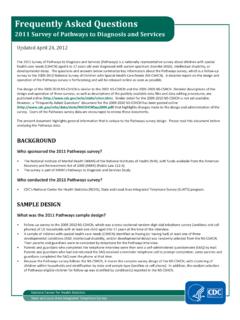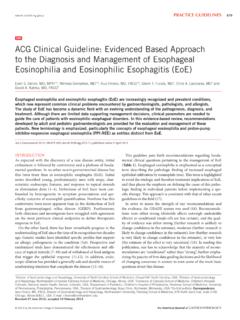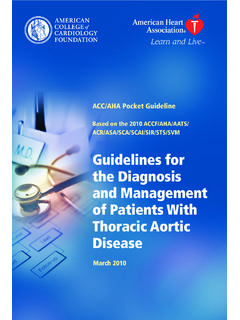Transcription of EVIDENCE-BASED CLINICAL MEDICINE Approach …
1 EVIDENCE-BASED CLINICAL MEDICINEA pproach to Leg Edema of Unclear EtiologyJohn W. Ely, MD, MSPH, Jerome A. Osheroff, MD, M. Lee Chambliss, MD, MSPH, andMark H. Ebell, MD, MSA common challenge for primary care physicians is to determine the cause and find an effective treat-ment for leg edema of unclear etiology. We were unable to find existing practice guidelines that addressthis problem in a comprehensive manner. This article provides clinically oriented recommendations forthe management of leg edema in adults. We searched on-line resources, textbooks, and MEDLINE (usingthe MeSH term, edema ) to find clinically relevant articles on leg edema. We then expanded the searchby reviewing articles cited in the initial sources. Our goal was to write a brief, focused review thatwould answer questions about the management of leg edema. We organized the information to make itrapidly accessible to busy clinicians. The most common cause of leg edema in older adults is venousinsufficiency.
2 The most common cause in women between menarche and menopause is idiopathicedema, formerly known as cyclic edema. A common but under-recognized cause of edema is pulmo-nary hypertension, which is often associated with sleep apnea. Venous insufficiency is treated with legelevation, compressive stockings, and sometimes diuretics. The initial treatment of idiopathic edema isspironolactone. Patients who have findings consistent with sleep apnea, such as daytime somnolence,load snoring, or neck circumference>17 inches, should be evaluated for pulmonary hypertension withan echocardiogram. If time is limited, the physician must decide whether the evaluation can be delayeduntil a later appointment (eg, an asymptomatic patient with chronic bilateral edema) or must be com-pleted at the current visit (eg, a patient with dyspnea or a patient with acute edema [<72 hours]). If theevaluation should be conducted at the current visit, the algorithm shown in Figure 1 could be used as aguide.
3 If the full evaluation could wait for a subsequent visit, the patient should be examined briefly torule out an obvious systemic cause and basic laboratory tests should be ordered for later review (com-plete blood count, urinalysis, electrolytes, creatinine, blood sugar, thyroid stimulating hormone, andalbumin). (J Am Board Fam Med 2006;19:148 60.)Edema is defined as a palpable swelling caused byan increase in interstitial fluid volume. The mostlikely cause of leg edema in patients over age 50 isvenous insufficiency. Venous insufficiency affectsup to 30% of the population,1,2whereas heart fail-ure affects only approximately 1%.3,4 The mostlikely cause of leg edema in women under age 50 isidiopathic edema, formerly known as cyclic patients can be assumed to have one ofthese diseases unless another cause is suspectedafter a history and physical examination. However,there are at least 2 exceptions to this rule: pulmo-nary hypertension and early heart failure can bothcause leg edema before they become clinically ob-vious in other are 2 types of leg edema: venous edema andlymphedema.
4 Venous edema consists of excess low-viscosity, protein-poor interstitial fluid resultingfrom increased capillary filtration that cannot beaccommodated by a normal lymphatic consists of excess protein-rich inter-stitial fluid within the skin and subcutaneous tissueresulting from lymphatic thirdtype, lipidema, is more accurately considered aform of fat maldistribution rather than true April 2005; revised 1 June 2005; accepted 6 June Department of Family MEDICINE , University ofIowa Carver College of MEDICINE , Iowa City, IA (JWE);Thomson MICROMEDEX, Greenwood Village, CO(JAO); Moses Cone Hospital Family MEDICINE Residency,Greensboro, NC (MLC); and Department of Family Prac-tice, Michigan State University, East Lansing, MI (MHE).Conflict of interest:none author:John W. Ely, MD, MSPH, Univer-sity of Iowa College of MEDICINE , Department of FamilyMedicine, 200 Hawkins Drive, 01291-D PFP, Iowa City, IA52242 (E-mail: April 2006 Vol.)
5 19 No. 2 differential diagnosis of edema is presented inTables 1 through 3. Figures 1 through 5 provide analgorithm for diagnostic elements of the history include What is thedurationof the edema (acute [ 72hours] vs. chronic)? If the onset is acute, deepvein thrombosis should be strongly ,9 11 The 72-hour cutoff is commonly cit-ed9 11but arbitrary and not well supported withevidence. Deep vein thrombosis should be con-sidered in patients presenting after 72 hours withotherwise consistent findings. Is theedemapainful? Deep vein thrombosis andreflex sympathetic dystrophy are usually ,12 Chronic venous insufficiency can causelow-grade aching. Lymphedema is usually ,10,12 15 Whatdrugsare being taken? Calcium channelblockers, prednisone, and anti-inflammatory drugsare common causes of leg ,14,16,17 Otherdrugs that may cause edema are listed in Table 4. Is there a history ofsystemic disease(heart, liver, orkidney disease)? Is there a history of pelvic/abdominalneoplasmorradiation?
6 Table 1. Common Causes of Leg Edema in the United StatesUnilateralBilateralAcute ( 72 hours)ChronicAcute ( 72 hours)ChronicDeep vein thrombosisVenous insufficiencyVenous insufficiencyPulmonary hypertensionHeart failureIdiopathic edemaLymphedemaDrugsPremenstrual edemaPregnancyObesityTable 2. Less Common Causes of Leg Edema in the United StatesUnilateralBilateralAcute ( 72 hours)ChronicAcute ( 72 hours)ChronicRuptured Baker s cystSecondary lymphedema (tumor,radiation, surgery, bacterialinfection)Bilateral deep vein thrombosisRenal disease (nephroticsyndrome, glomerulonephritis)Ruptured medial head ofgastrocnemiusPelvic tumor or lymphomacausing external pressure onveinsAcute worsening of systemic cause(heart failure, renal disease)Liver diseaseCompartment syndrome Reflex sympathetic dystrophySecondary lymphedema(secondary to tumor, radiation,bacterial infection, filariasis)Pelvic tumor or lymphomacausing external pressureDependent edemaDiuretic-induced edemaDependent edemaPreeclampsiaLipidema8 to Leg Edema of Unclear Etiology 149 Does the edemaimprove overnight?
7 Venousedema is more likely than lymphedema to im-prove Is there a history consistent withsleep apnea?Sleep apnea can cause pulmonary hypertension,which is a common cause of leg may increase suspicion of sleep apnea in-clude loud snoring or apnea noted by the sleeppartner, daytime somnolence, or a neck circum-ference 17 ExaminationKey elements of the physical examination include Body mass index. Obesity is associated with sleepapnea and venous 20 Distribution of edema:unilateralleg edema isgenerally due to a local cause such as deep veinthrombosis, venous insufficiency, or can be due to a local causeor systemic disease, such as heart failure or kid-Table 3. Rare Causes of Leg Edema in the United StatesUnilateralBilateralAcute ( 72 hours)ChronicAcute ( 72 hours)ChronicPrimary lymphedema (congenitallymphedema, lymphedema praecox,lymphedema tarda)Primary lymphedema (congenitallymphedema, lymphedema praecox,lymphedema tarda)Congenital venous malformationsProtein losing enteropathy, malnutrition,malabsorptionMay-Thurner syndrome (iliac-veincompression syndrome)51 Restrictive pericarditisRestrictive cardiomyopathyBeri BeriMyxedemaFigure 1.
8 Algorithm for leg April 2006 Vol. 19 No. 2 is due to systemicdisease. The dorsum of the foot is spared inlipidema but prominently involved in Tenderness: deep vein thrombosis and lipidemaare often tender. Lymphedema is usually non-tender. Pitting: deep vein thrombosis, venous insuffi-ciency, and early lymphedema usually pit. Myx-edema and the advanced fibrotic form oflymphedema typically do not ,12,14,21 Varicose veins: leg varicosities are often presentin patients with chronic venous insufficiency, butvenous insufficiency can occur without Kaposi-Stemmer sign: inability to pinch a fold ofskin on the dorsum of the foot at the base of thesecond toe is a sign of ,22 Skin changes: a warty texture (hyperkeratosis)with papillomatosis and brawny induration arecharacteristic of chronic ,14 Brownhemosiderin deposits on the lower legs and an-kles are consistent with venous insufficiency. Re-flex sympathetic dystrophy initially leads to warmtender skin with increased sweating.
9 Later theskin is thin, shiny, and cool. In the chronic stage,the skin becomes atrophic and dry with flexioncontractures. Signs of systemic disease: findings of heart failure(especially jugular venous distension and lungcrackles) and liver disease (ascites, spider heman-giomas, and jaundice) may be helpful in detectinga systemic StudiesLaboratory TestsMost patients over age 50 with leg edema havevenous insufficiency, but if the etiology is unclear,a short list of laboratory tests will help rule outsystemic disease: complete blood count, urinalysis,electrolytes, creatinine, blood sugar, thyroid-stim-ulating hormone, and albumin. A serum albuminbelow 2 g/dL often leads to edema and can becaused by liver disease, nephrotic syndrome, orprotein-losing tests areindicated depending on the CLINICAL presentation: Patients who may have acardiac etiologyshouldhave an electrocardiogram, echocardiogram, andchest radiograph. Dyspneic patients should havea brain natriuretic peptide (BNP) determinationto help detect heart failure.
10 The BNP is mosthelpful for ruling out (rather than ruling in) heartfailure because the sensitivity is high (90%).23 Idiopathic edemacan be diagnosed in youngwomen without further testing if there is no rea-son to suspect another etiology based on historyand physical , tests toconfirm idiopathic edema have been describedand may be helpful in difficult cases (Table5).12,24 Figure 2. Common to Leg Edema of Unclear Etiology 151 In patients withacute edema( 72 hours), a nor-mal D-dimer will essentially rule out deep veinthrombosis if the CLINICAL suspicion is low becausefalse negative D-dimers are 27 However,an elevated D-dimer should be followed up witha Doppler examination because false positive D-dimers are variability amonglaboratory assays has been problematic, but arecent systematic review recommended the rapidquantitative ELISA as the most useful Patients with possiblenephrotic syndromeshouldhave serum lipids in addition to the basic labora-tory studies listed StudiesPatients over age 45 with edema of unclear etiologyshould have an echocardiogram to rule out pulmo-nary can behelpful to distinguish lymphedema from venousedema and to determine the cause of is performed by injecting aradioactive tracer into the first web space and mon-itoring lymphatic flow with a gamma Causes of Leg EdemaVenous InsufficiencyVenous insufficiency is characterized by chronicpitting edema.








